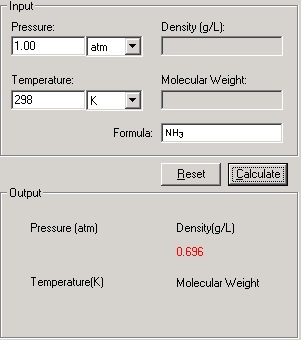The Ideal Gas Law is an equation of state for a gas, which describes the relationships among the four variables temperature (T), pressure (P), volume (V), and moles of gas (n). One modified form of the Ideal Gas equation is to involve the density (d) and molecular weight (M) instead of volume (V) and moles (n).
The mathematical form of the Ideal Gas Law is:
PV = nRT and n = m/MW and d = m/V
Where:
P - pressure
V - volume
n - number of moles
T - temperature
m - mass
d - dendity
MW - Molecular Weight
R - ideal gas constant. If the units of P, V, n and T are atm, L, mol and K, respectively, the value of R is 0.0821 L x atm/K x mol or 8.314 J/K x mol.
The density (d) of a gas is defined as
d = m / V
and the moles of a gas is:
n = m / MW
Where
m is the mass of the gas, and
MW is the molecular weight.
Substituting the definitions to the original Ideal Gas equation, it becomes:
d = P x MW / (R x T)
When any three of the four quantities in the equation are known, the forth can be calculated. For example, we've known d, P and T, M can be:
MW = d x R x T / P
The force exerted per unit area of surface, typical pressure units are ATM, mmHg and kPa.
The measurement of space taken by a substance, it is length cubed, typical units are L, mL and m3.
A measure of the average kinetic energy of the particles in a sample of matter, expressed in terms of units or degrees designated on a standard scale. Typical units are K, F and C.
The mass of the object divided by its volume. Typical units are g/mL and kg/m3.
The formula weight of a compound is the sum of all the atomic weights of the elements present in the formula of the compound. Some text also refers it to formula mass. Typical unit is g/mol.
Mass is the amount of a substance in grams, also called weight.
The constant that appears in the ideal gas equation (PV=nRT). It is usually expressed as 0.08206 L x atm/K x mol or 8.314 J/K x mol.
The number of moles of solute dissolved in one kilogram of solvent.
The number of moles of solute in one liter of solution.
Using this equation of MW = d x R x T / P, calculate any one of four quantities (P, V, n, T) if given three.
In addition to the problem solving module, the "Show Work" is also displayed along with the solution to illustrate the step-by-step guide in how your problem has been solved.
This module is to compute any one of the four variables of a gas in the known other three according to the Gas Law equation.
This is one step process, enter the known data and press Calculate to output the unknowns.
1. Select Ideal Gas Law with Density link from the front page or Ideal Gas with Density tab from the Gases module. The Input and Output screen appears.
2. In the Input area, enter the known quantities with a proper significant figure. Select the units associated with the input.
You do not have to enter the molecular weight, if preferred, you can enter the molecular formula instead. See the next section in how to input a formula. The way to input formula is consistent throughout the entire program.
3. Click Calculate to output the answer.

4. The Show Work area on the right shows you step-by-step how your problem has been solved.
To start a new problem, click Reset. All Input fields will be cleared. Follow Step 1-3 again.
In this program, entering text for molecular formula and chemical equation is rather straight-forward with relatively free style. The program follows chemist's rules, as appeared in chemistry text books. Here are the detailed instruction for entering a formula:
Formula is input as is, element symbols should start with capital letter and follow by low-case letter if dual-letter elements (e.g. for sodium, Na is correct, but NA, nA or na is not acceptable).
Subscription or superscription is entered by typing the upper(subscript)/lower(superscript) arrow keys on the keyboard.(e.g. for SO42-, the keystroke sequence is <S>-<O>-<Down-Arrow>-<4>-<Up-Arrow>-<2>-<Up-Arrow>-<->.